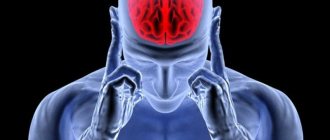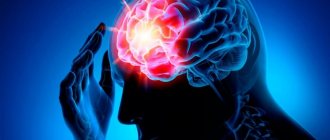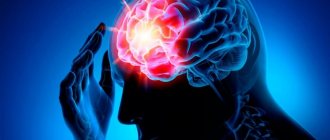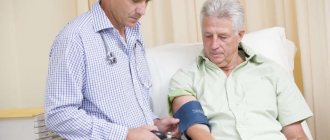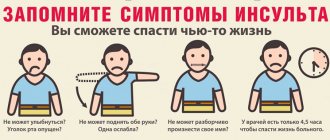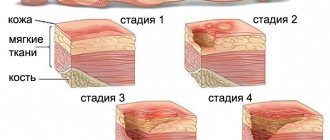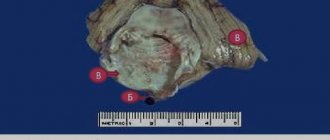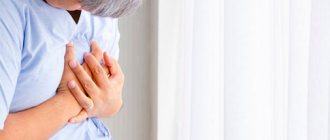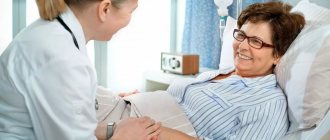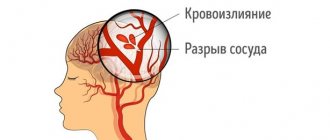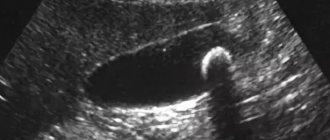Stroke, or acute cerebrovascular accident, remains one of the leading causes of death.
Practice shows that in 60% of cases the lesion is localized in the left brain structures, which control the activity of the right half of the body, where paralysis occurs. Just a few minutes of stopping blood flow is enough to kill millions of neurons and create a dead zone in the nervous tissue. The pathological process involves the pathways of CNS signals to systems and organs on the right.
Kinds
Neurology defines two types of stroke with paralysis of the right side:
- Ischemic stroke. Occurs due to blockage of cerebral vessels by atherosclerotic plaques and blood clots. In the area of circulatory arrest, a focus of brain tissue necrosis occurs. The severity of subsequent paralysis and the ability of the central nervous system to compensate for lost functions depend on its location and size. The disease most often threatens hypertensive patients, diabetics, smokers and anyone with high cholesterol, thrombophlebitis, blood thickening, or problems with heart rhythm. Attacks of tachycardia or atrial fibrillation can provoke the formation of blood clots in the heart cavity, which enter the brain vessels with the blood flow. This type of stroke develops over 2-3 days or longer, so it has specific diagnostic features.
- Hemorrhagic stroke. It is characterized by a rupture of the vascular wall and a breakthrough of blood into the brain tissue, which dies from ischemia. It is provoked by a hypertensive crisis, specific aggregate states of the blood, diseases that cause pathological changes in the structure of blood vessels. Hemorrhagic stroke develops rapidly, quickly causing a coma in the patient. This diagnosis entails the most severe consequences.
The practice of neurology shows that strokes with paralysis of the right side are easier and the consequences are eliminated faster. This is explained by the fact that ischemic stroke more clearly manifests the onset of the disease with characteristic signs. Additional time is provided to recognize the illness and transport the patient to a medical facility. The earlier therapeutic actions are started, the less severe the consequences will be. Neurologists call this the stroke race.
Expert opinion
Author: Ekaterina Dmitrievna Abramova
Neurologist, director of the chronic pain clinic
According to the Federal State Statistics Service, stroke ranks second in the structure of mortality. This is a dangerous neurological disease, the incidence of which is increasing every year. Statistics show that acute cerebrovascular accident occurs in every third person per 1000 population. Stroke in 60% of cases leads to disability. Due to severe complications, 10% of patients completely lose the ability to self-care. The appearance of persistent paralysis is associated with extensive brain damage.
A stroke requires immediate diagnosis and correct treatment. At the Yusupov Hospital, examinations are carried out using the latest medical equipment: CT, MRI. Thanks to them, it is possible to accurately determine the location of the pathological focus. Doctors at the Yusupov Hospital develop an individual treatment and rehabilitation plan for each patient. The drugs are selected in accordance with the latest European recommendations for the treatment of strokes. Conservative treatment can be supplemented with surgical intervention if indicated. In addition, to speed up recovery, physiotherapy and a course of physical therapy are prescribed.
Types of paralysis on the right side
According to the nature and localization of vascular accidents, the types and subtypes of paralysis are classified:
Central paralysis
It develops when the areas of the brain and spinal cord responsible for the function of movement and the state of the neuromuscular complex are damaged. Characterized by specific spastic reactions. With the central form of paralysis, all muscles are affected, which are in constant tension, and when calm they show clonus - rhythmic twitching, mainly in the area of the knees and feet. In many areas, diagnostic reflexes are absent or weakened. Hypertonicity of the muscles causes their painful tightening with a high degree of resistance. This causes painful contractures due to stretching of the tendons. With tension, tremor of the affected limb is often observed. There is a weakening of the facial muscles and articulation disorders. These markers indicate in which part of the brain the pathological focus is located, which subsequently determines the place where restorative measures need to be carried out.
Peripheral paralysis
With this type of stroke, a decrease or absence of neurological reflexes develops. The tone in the muscles is not determined, they atrophy, decrease in mass, patients lose the ability to move, self-care and generally do any activity. The main task is to restore the conduction pathways of impulses from the brain and spinal cord to the neuromuscular system. By the nature of the pathological symptoms and the areas of their location, it is possible to determine which segments of the central nervous system are out of order. For example, damage to the anterior horns of the spinal cord in the region of the 6-7 cervical and first thoracic vertebrae causes peripheral paralysis of the arm. In the lumbar region there is paralysis of the leg. There is atrophy of small muscles - facial, oculomotor, sublingual, laryngeal, tracheal muscles. Accordingly, the process negatively affects the ability to swallow, vision, breathing, etc.
Recovery period after acute cerebrovascular accident
Once the threat of a recurrent stroke and the consequences of the disease have been averted, the most important moment comes - the work that is associated with the restoration of lost body functions. The recovery plan includes:
- The patient needs to undergo physiotherapeutic procedures and sanitary treatment;
- It is strongly recommended to carry out daily special gymnastics at home;
- Carefully monitor your diet, create a diet, taking into account the recommendations of doctors.
People who have suffered an ischemic stroke and managed to survive are prohibited from eating foods that contain a lot of cholesterol, such as eggs, meat, caviar, and mayonnaise. It is necessary to limit or even completely eliminate spicy foods and excessive consumption of sweets from the diet.
Causes
The main cause of right-sided paralysis is strokes, chronic and then acute disturbances of blood supply in the structures of the left hemisphere. Nerve tissues are very sensitive to hypoxia. And even if the necrotic focus is significantly removed from the brain capsule, paralysis of the right side of the body still occurs. Most often the hand is affected.
A stroke is not a disease that happens suddenly. Its causes accumulate over years, decades, so that when a critical point is reached, one day the scenario of a “vascular catastrophe” unfolds. This leads to:
- Physical inactivity;
- Diet with a predominance of animal fats and proteins;
- Metabolism, carbohydrate and cholesterol status disorders;
- Limited or inadequate sleep;
- Abuse of tobacco, alcohol, drugs;
- Chronic or severe one-time stress.
Eliminating at least half of these causes will allow stroke to be removed from the list of major diseases that most often suffer in our time.
A little about pathology
In general, a stroke is a paroxysmal (sharp) disruption of the blood supply to brain tissue , leading to disruption of the functions of the affected parts.
The brain coordinates the activity of all tissues, systems and organs of the human body, and therefore damage to any part of it leads to serious consequences.
During a stroke, nerve cells die, which causes irreversible processes.
In the right hemisphere of the brain there are centers responsible for motor abilities, sensitivity, motor skills, coordination, and muscle tone. They regulate everything that is located on the left side of the body (left limbs, eye, ear), while incoming information is processed simultaneously in both hemispheres, and problems are solved entirely.
The functions of this hemisphere include understanding of words, touch, speed of hearing, spatial perception, breadth of visual perception, intuition, mathematical abilities (including recognition of geometric shapes), reading and writing, and perception of music. During a stroke, all or many of these functions are disrupted.
Symptoms
The signs of the onset of an illness are beyond doubt; not only doctors, but also ordinary people should know them in order to help their loved ones, acquaintances, or just a person on the street who has become ill in time. You should call the emergency room immediately if you experience the following symptoms:
- Sudden loss of speech (or when it becomes slurred);
- Inability to move an arm or leg;
- Inability to smile (the right side of the mouth sags);
- drooping eyelid;
- State of stupefaction, spatial and temporal disorientation, the patient complains of “mess in the head”;
- Severe headache with vomiting, dizziness;
- The extended right leg turns the foot inward;
- The right arm is bent and pressed towards the body.
Consequences
If patients can be saved, they experience neurological deficits—symptoms caused by damage to the area of the brain where the hemorrhage occurred.
These may be consequences of a hemorrhagic stroke:
- paresis and paralysis - impaired movement of the limbs on one half of the body, since they are constantly in a half-bent position and it is impossible to straighten them;
- speech impairment and its complete absence;
- mental disorders and irritability;
- constant headaches;
- movement coordination disorders;
- inability to walk or even sit independently;
- visual impairment up to complete blindness;
- facial distortion;
- vegetative state - the absence of any signs of brain activity (consciousness, memory, speech, movements) with preserved breathing and heartbeat.
Symptoms of the disease and their duration depend on the location of the hemorrhage and its volume. The first 3 days are the most dangerous, since during this time severe disorders occur in the brain. Most deaths (80–90%) occur during this period. The remaining 10–20% of patients die within one to two weeks. Patients who survive recover gradually from a few weeks to 9–10 months.
Treatment
Thanks to the efforts of healthcare organizers, the system of stroke treatment in Russia has undergone positive changes. It has become the norm to transport patients with suspected cerebral circulatory disorders to an intensive care bed or neurosurgeon's table within three hours. There are 24-hour vascular centers in all major cities. Specialized structures like the Moscow Yusupov Hospital, which have invaluable experience in treating and rehabilitating the most complex neurological diseases, received support.
Treatment for stroke, when the right side is paralyzed, begins in the intensive care unit, where patients are hospitalized urgently. The treatment regimen provides for the normalization of blood circulation in the brain, restoration of respiratory and swallowing functions, and elimination of the threat of convulsive phenomena. The fight against cerebral edema, the normalization of the body’s water and electrolyte balance, and the metabolic processes of the central nervous system are being actively carried out.
The treatment regimen for hemorrhagic stroke with paralysis of the right side is somewhat different. In this case, drugs that eliminate thromboembolism come to the fore. If treatment is started on time, the blood clot is destroyed and impaired blood flow is restored. Thanks to modern medications, it is often possible to completely avoid the consequences of a stroke.
The patient's condition requires normalization of homeostasis, a decrease in the degree of permeability of the vascular walls and the formation of plasmin.
In some cases, blood clots from brain vessels are removed surgically in neurosurgery departments.
Drug therapy
Subsequent treatment occurs with the help of drugs: neuroprotectors, antiplatelet agents, anticoagulants, thrombolytics, defibrinizing enzymes, antihypertensive drugs. The composition and duration of medication may be varied by your doctor. But several drugs must be taken for life to prevent stroke.
Lifestyle
Stroke is a disease in which a person must start life in new conditions. Most people find it difficult to accept their condition, so deep depression is as dangerous a complication as the physical manifestations. Already in the first stages of recovery, much attention is paid to this aspect. Specialists at the Yusupov Hospital - neurodefectologists, neuropsychologists, occupational therapists, rehabilitation specialists, working with patients in groups and individually, help them overcome a depressed, anxious state, gain confidence in their abilities to overcome the disease, and follow the rules of a healthy lifestyle. These are changes in the principles of nutrition with a predominance of vegetable and dairy products, reasonable physical activity, giving up bad habits, training the functions of the nervous, muscular, and cardiovascular systems.
The scientific, material and technical base of the Yusupov Hospital allows patients to undergo rehabilitation procedures using modern equipment that meets European standards. And the friendly, optimistic attitude of rehabilitators helps make sure that the simulator is as important and necessary as the pill.
The cause of the disease was lifestyle. It becomes a means of overcoming it.
Right side massage
Recovery after a stroke with paralysis of the right side with the help of massage begins on the 20th day of illness. This is an average date; the severity of the patient’s condition, age, concomitant diseases, etc. are taken into account.
The first massage sessions begin with gentle stroking of the limbs, back and neck muscles. The intensity of the effect increases from session to session, the massage therapist’s actions are aimed at restoring normal blood circulation and sensitivity in the affected part of the body. If the treatment is well tolerated, a course of manual therapy is subsequently prescribed, which demonstrates good results in a short time. A course of physical therapy, physiotherapeutic, kinesiotherapeutic procedures, and acupuncture to restore limb mobility is recommended.
The Yusupov Hospital has a full range of rehabilitation equipment, including innovative ones, and a staff of highly qualified specialists who are proficient in modern techniques and types of massage and physical therapy. Their efforts, led by the country's best neurologists, are helping people recover from stroke paralysis.
First aid for stroke
A quick reaction from relatives who can provide first aid to an old person after a stroke will help prevent serious consequences and provide the necessary treatment in the future.
So what needs to be done:
- position the patient so that the legs are 25–30 degrees below the head;
- try to determine blood pressure and pulse indicators, record them;
- if the patient has lost consciousness, do not try to move him to the bed, just lay him down correctly and leave him alone;
- After the ambulance doctors arrive, talk clearly and intelligently about the person’s previous condition, the medications he is taking, and the visible symptoms of the attack.
There are actions that doctors strictly prohibit taking. Under no circumstances should you:
- use ammonia when recovering from a fainting state;
- hold limbs during convulsions;
- try to offer the patient medications that may get stuck when swallowing (it is better to completely stop taking medications until specialists arrive).
We recommend
“Low blood pressure in an elderly person: treatment and prevention” Read more
Fighting bedsores
Bedsores are a dangerous enemy of bedridden patients who have to remain in bed for long periods of time. Bedsores appear in areas that are subject to the greatest pressure - the tailbone, shoulder blades, buttocks, legs, forearms.
The skin here becomes thinner, and zones of necrosis form. The most effective fight against bedsores is prevention. It is important to change body position as often as possible, lay the patient on his side, keep the skin clean, carry out daily hygiene procedures, and treat problem areas with disinfectant and softening solutions.
Bedsores in advanced stages require surgical treatment. There are cases when a patient was saved in intensive care, but then, due to poor care, he died from sepsis that developed from banal bedsores. Nursing after a stroke is exactly the case when an experienced and conscientious nurse is just as important as a doctor. And sometimes it’s even more important.
The main thing is to see a doctor in time
The doctor who treats strokes is a neurologist. He takes part in the restoration of lost mental and physical functions. The main tasks of a specialist when working with patients who have already been discharged from the hospital are secondary prevention, which is aimed at preventing a recurrent attack, as well as drug treatment of the consequences of the “stroke”.
A modern method for diagnosing pathology is ultrasound duplex scanning of neck vessels. An image of the vessel is formed, its patency and structure are displayed. Diagnostics allows timely detection and prevention of vascular diseases, including stroke.
You need to undergo the study if:
- frequent fainting, headaches, dizziness;
- hypertension;
- arrhythmias;
- elevated cholesterol levels;
- traumatic brain injuries;
- sleep, vision and hearing disorders;
- weakened attention, memory loss.
The necessary studies are prescribed by a neurologist. Based on diagnostic data, treatment is prescribed, which varies depending on the type of stroke.
Our clinic address: St. Petersburg, st. Bolshaya Raznochinnaya, 27 metro station Chkalovskaya
Complications
Neurologists have to deal with numerous complications of the physical and psychological state of a stroke, which include:
- Gross disturbances of mental, cognitive, speech activity;
- Perceptual inhibition;
- Inflammatory phenomena of the bronchopulmonary, genitourinary system due to congestion in an immobilized patient;
- Depressive states with suicidal statements.
These manifestations require the closest attention and active therapy from specialists in various fields.
Types of pathology
Taking into account the etiological mechanism, right-sided stroke is divided into 2 main types:
Ischemic stroke. This type occurs against the background of a disturbance in the blood flow entering the right hemisphere of the brain.
It develops as a result of complete or partial blockage of blood vessels or a deterioration in the supply or speed of blood movement.
Along with blocking the flow of blood into the tissues, the delivery of oxygen is limited, which leads to oxygen starvation of nerve cells, their death and tissue necrosis. With ischemia, brain damage occurs gradually, and therefore symptoms (in almost 80% of cases) increase over several hours, or even 1-2 days.
The pathology is provoked by thrombosis, embolism, cholesterol and atherosclerotic plaques, deformation and compression of blood vessels, blood thickening, cardiac problems, congenital vascular defects, arterial hypertension (especially with frequent pressure surges).
Hemorrhagic stroke. It is a hemorrhage in the tissue of the right hemisphere as a result of rupture of blood vessels. The main causes are high arterial and intracranial pressure, disruption of the structure of blood vessels, and trauma. With hemorrhage, cerebral edema develops, which often leads to coma.
Reference: Ischemic damage to the right side of the brain is most often recorded. Hemorrhage occurs much less frequently, but the consequences are severe. Based on the size of the lesion, such pathologies are divided into small and massive lesions. Microstrokes with point lesions are distinguished separately.
Forecasts
Experienced neurologists know that the consequences of a stroke cannot be predicted. It is not for nothing that this disease is translated from Latin as “insidious blow, attack.” Often the most pessimistic forecasts are refuted by the amazing plasticity of the brain, when the load of the dead area is taken on by neighboring and even distant neuron cells. The paralyzed man rises and returns to life. And vice versa: a patient who easily suffered a stroke with a positive prognosis, but returned to his previous lifestyle, receives a new stroke within a year. Already fatal.
In modern medicine, forecasts quickly become outdated, new methods and specializations appear. Yesterday's wheelchair-bound or bedridden patients have the opportunity to be restored using IT technologies, developments in biotechnology that create fundamentally new medicines, innovative tools such as exo-skeletons that teach paralyzed people to walk again. Breakthrough ideas are expected in scientific neurology, which has proven that neurogenesis (the production of new neurons even in the elderly) exists, contrary to popular belief that nerve cells do not regenerate. A method currently being tested for growing neurons from a patient's blood cells holds great promise. Neurologists will be able to repair the brain, replacing diseased areas with new ones. And this fantastic tomorrow is much closer than we can imagine.
Today, a favorable prognosis for the disease for many years depends on many factors. And the main one is the right choice of a medical institution and the choice of a doctor.
Features of therapy
{banner_banstat4}
Complex therapy for right-sided stroke is divided into correction of the acute period and rehabilitation. During the acute period, if there is a risk of severe consequences, surgical intervention may be required. The patient remains in the intensive care unit throughout the acute period. Treatment of right-sided stroke of any origin is carried out in several areas:
- basic: for ischemia - thrombolytics, disaggregants, anticoagulants (thrombolysis with a recombined type plasminogen activator is most effective), for hemorrhage - emergency hemostatic and vasoconstrictor agents;
- hypotensive: drugs that lower blood pressure relieve compression of nerves, remove tissue pastiness (Betalok, Stugeron, Triampur);
- normalizing cerebral blood flow: drugs with vasoactive and antiplatelet properties (Trental, Cavinton, Eufillin);
- neuroprotective: restore connections between neurons (Cellex);
- antioxidant: detoxify tissues, remove free radicals, renew cells (Vitamin E, C, Lycopene).
In the acute phase, it is important to control breathing, heart rate, and body temperature. Treatment is most effective during the first three, maximum five hours after the attack. Within a day, irreversible processes occur in neurons.
Is it possible to drive the car?
Many victims are interested in the question of their ability to drive a car. The medical commission will not give permission to transport passengers after a stroke. Moreover, it is not recommended to drive personal vehicles. After completing a full course of rehabilitation, there remains a risk of impaired orientation and reaction speed, which can manifest itself in difficult situations.
Even after suffering a mild stroke, you should not drive before 6 months after completing the recovery phase. It should also be remembered that driving causes increased psychological stress, which can cause a relapse of the pathology.
